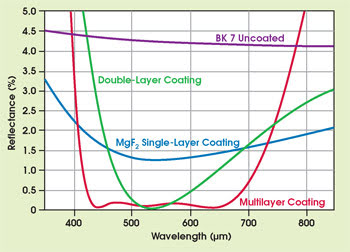System enhancements from the use of tandem plasma sources to higher power per source should help reduce the cost of complex coating processes, even at higher volumes.
Michael Sander, Leybold Optics GmbH
Even as the telecom market bubble burst, advances in optical coating technology developed for telecom applications began fueling advances in other application areas. Dense wavelength division multiplexing filters, for instance, place exacting demands on the precision of the layer thickness as well as on requirements for low losses due to absorption and scattering.
The downturn in telecom caused many component manufacturers to look into new applications in which to capitalize on such expertise. Product technology that has already benefited from this knowledge includes color filters for video projectors, UV/IR cut filters for digital cameras and solar cells and multiple narrowband filters for analysis applications.

Antireflection coatings can reduce the reflection of an optical surface and improve component performance at a specific wavelength or over a waveband. Their effect varies depending on factors such as number of coating layers and coating type.
One ongoing trend is thus for optical coating applications — once considered very demanding — to become more cost-effective for higher-volume consumer products. Leybold Optics GmbH in Alzenau, Germany, for example, has reworked one of its systems for plasma-assisted electron beam evaporation to allow precision coating of larger surface volumes. Its largest coating system has almost double the plasma power of the previous model. The goal is the same level of quality, with 150 to 200 percent of the old capacity.
End users also will see use of ion-assist devices by the coating industry. Whether the technique is ion- or plasma-assisted coating, however, for a given chamber size, the deposition rate is usually restricted by the amount of plasma or ions that can be produced in the plasma source. The combined need for very low absorption and scattering, as well as for coating durability, translates into throughput limitations, both in the number of substrates coated per batch and the batch time, which has a direct impact on the cost per coated piece.
There is growing emphasis on two approaches to boost volume. One is to work with tandem (two) plasma sources. The pumping of the coating system must be capable of dealing with the higher gas flow fed into each source. When this technique was in development, the question was whether both sources would run without any adverse interference. The issue was resolved by a strategy to control each plasma source independently.
Also being explored is a plasma source that is 50 percent more powerful than current technology and that enables optical coating processes with twice the deposition rate of previous models. Besides a stronger power supply, an increase of the oxygen-to-argon ratio is essential here. Thus, more intense film densification is accompanied by significantly more effective oxidation, yielding very dense layers with even higher refractive index.
Future enhancements with this technology are expected to include the ability to arbitrarily vary plasma parameters via direct software control in conjunction with fast feedback regulation of the plasma source. This would improve control of layer stoichiometry, smoothness and stress, and should begin to affect the type of coatings possible within the next couple of years.
Advances also continue in other system components required to boost speed, with enhancements related to pump-down time, heating and optimized evaporation for different materials. These improvements are creating a new generation of high-speed coating processes, one of which has reduced total batch time of a green color filter to 2.2 hours.
End users can expect the trend toward optimized coating systems —which produce ever-more-complex multilayer optical films at lower cost — to continue bearing fruit. Falling prices of video projectors have, for instance, facilitated the transition of such technology from business customer products to more affordable home cinema. Farther out along the horizon, one can expect to benefit from technology such as integrated optical microchips composed of waveguides, photonic crystals and other photonic elements. This exciting trend, however, will have to continuously prove economically feasible in comparison with electronic semiconductor-based product solutions, which still greatly benefit from much higher production standardization.
End users also can expect some interesting market developments. European, US and Japanese companies already tend to focus more on optical coating capacity for special and complex coatings requiring expert process engineers. Mass production, on the other hand, appears to be shifting to facilities in Asia, especially Taiwan and China. This trend will certainly continue, which will only help drive competitively priced optical components into an increasing variety of products.
Meet the author
Michael Sander is the business unit manager for precision and telecom at Leybold Optics GmbH in Alzenau, Germany.